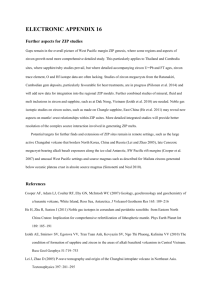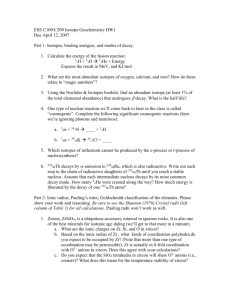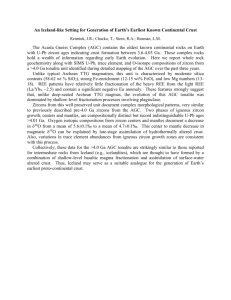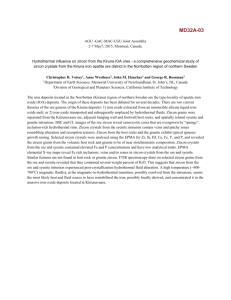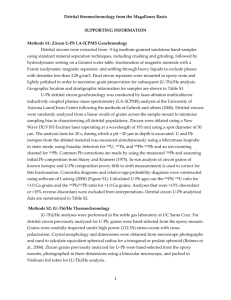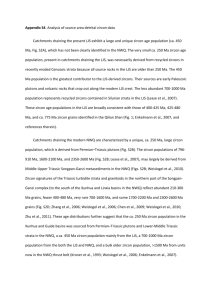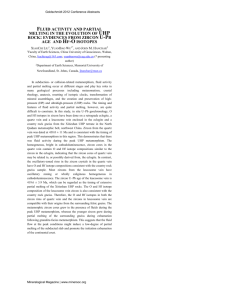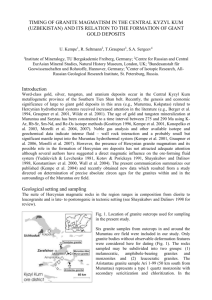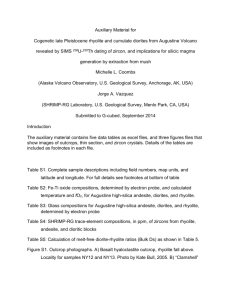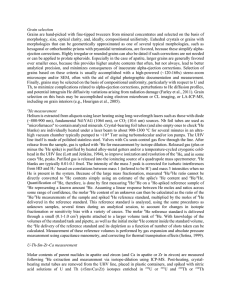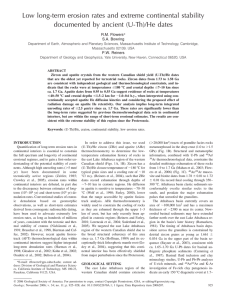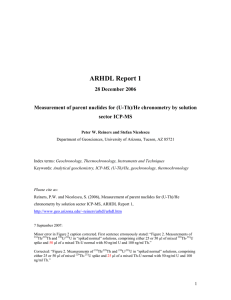tect20323-sup-0001-SupInformation
advertisement
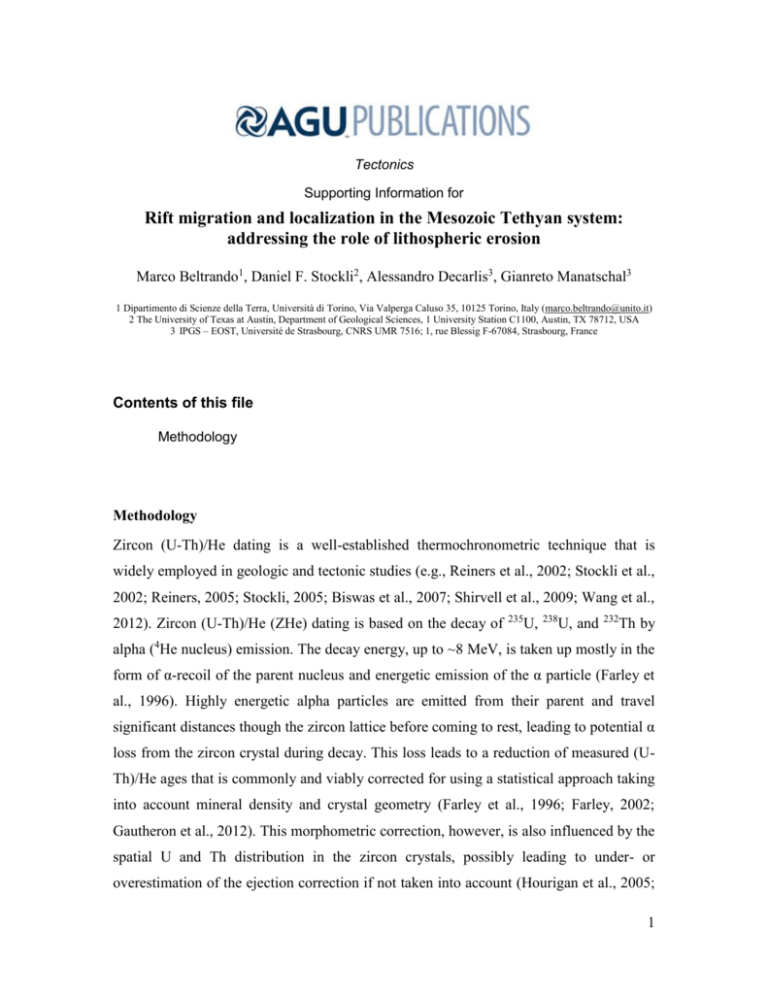
Tectonics Supporting Information for Rift migration and localization in the Mesozoic Tethyan system: addressing the role of lithospheric erosion Marco Beltrando1, Daniel F. Stockli2, Alessandro Decarlis3, Gianreto Manatschal3 1 Dipartimento di Scienze della Terra, Università di Torino, Via Valperga Caluso 35, 10125 Torino, Italy (marco.beltrando@unito.it) 2 The University of Texas at Austin, Department of Geological Sciences, 1 University Station C1100, Austin, TX 78712, USA 3 IPGS – EOST, Université de Strasbourg, CNRS UMR 7516; 1, rue Blessig F-67084, Strasbourg, France Contents of this file Methodology Methodology Zircon (U-Th)/He dating is a well-established thermochronometric technique that is widely employed in geologic and tectonic studies (e.g., Reiners et al., 2002; Stockli et al., 2002; Reiners, 2005; Stockli, 2005; Biswas et al., 2007; Shirvell et al., 2009; Wang et al., 2012). Zircon (U-Th)/He (ZHe) dating is based on the decay of 235 U, 238 U, and 232 Th by alpha (4He nucleus) emission. The decay energy, up to ~8 MeV, is taken up mostly in the form of α-recoil of the parent nucleus and energetic emission of the α particle (Farley et al., 1996). Highly energetic alpha particles are emitted from their parent and travel significant distances though the zircon lattice before coming to rest, leading to potential α loss from the zircon crystal during decay. This loss leads to a reduction of measured (UTh)/He ages that is commonly and viably corrected for using a statistical approach taking into account mineral density and crystal geometry (Farley et al., 1996; Farley, 2002; Gautheron et al., 2012). This morphometric correction, however, is also influenced by the spatial U and Th distribution in the zircon crystals, possibly leading to under- or overestimation of the ejection correction if not taken into account (Hourigan et al., 2005; 1 Bargnesi and others, in press). 4 He is completely expelled from zircon at temperatures above ~180°C and almost totally retained below ~130°C (termed the Zircon He Partial Retention Zone, ZHePRZ) (e.g., Reiners et al., 2004; Stockli, 2005; Wolfe et al., 2010). The ZHePRZ spanning a temperature range from ~130-180°C an effective temperature sensitivity window that is equivalent to depths of ~5 to 7 km, assuming a mean annual surface temperature of 10±5° C and a geothermal gradient of 25°C/km. More recently, it has been shown that both apatite and zircon He diffusion kinetics are systematically modulated by radiation damage. While in apatite the He retentivity increased with increasing radiation damage dose (e.g., Shuster at al., 2006; Flowers et al., 2009), zircon appears to become less retentive with higher doses of accumulated radiation damage before being completely metamict (e.g., Nasdala et al., 2004; Guenthner et al., 2013). A first order proxy of the influence of radiation damage on ZHe ages is their correlation with effective U concentration (Ue [ppm]), although this relationship does not take into account any annealing of the radiation damage. The age-Ue correlation can, however, be used to qualitatively evaluate slow vs fast cooling and to quantitatively model possible thermal histories using the approximation of Guenthner and others (2014) or other evolving models For this study, all ZHe analysis was performed at the Geo- and Thermochronometry Laboratory of the University of Texas at Austin. After routine mineral separation of zircon, single crystals were hand selected picked on similarity in morphology, clarity, and size (>60 μm in width). Morphometric analysis of each grain measured length and width to calculate the alpha ejection correction factor. Single crystal zircon aliquots were wrapped in 1mm Pt tubes and laser heated with a 75 W Photonmachine Diode for 10 min at ~1300°C. Laser He extraction was repeated until residual He yields were <1% to ensure complete degassing of the sample. Extracted gas was spiked with a 3He tracer, cryogenically purified, and measured by isotope dilution on a quadrupole noble gas mass spectrometer. After He extraction, zircon grains were retrieved and unwrapped from Pt tubing before pressure vessel digestion procedure, to avoid PtAr isobaric interferences. Samples were spiked prior to acid digestion with an isotopically enriched 230 Th-235U tracer, subsequent two-stage dissolution using a HF-HNO3 mixture for 72 h at 225°C and 6 N HCl for 12 h at 200°C to ensure complete dissolution. All parent nuclide 2 concentrations were measured by isotope dilution on a Thermo Element2 HR- ICP-MS, comparing the spike against a gravimetric 1 ppb U–Th–Sm–REE normal solution. (U– Th)/He ages of unzoned zircon grains were calculated using standard FT corrections (Farley et al., 1996). Estimated analytical uncertainty of ~8% (2σ) is based on a decade of replicate analysis of Fish Canyon Tuff ZHe age standard (28.2± 2.3 Ma; n > 2200). Cited references: Bargnesi, E., Stockli, D.F., Hourigan, J., Shuster, D., in press, Improved accuracy of zircon (U-Th)/He ages by rectifying parent nuclide zonation with practical methods. Chemical Geology. Biswas, S., I. Coutand, D. Grujic, C. Hager, D. Stockli, and B. Grasemann, 2007, Exhumation and uplift of the Shillong Plateau and its influence on the eastern Himalayas: New constraints from apatite and zircon (UTh‐[Sm])/He and apatite fission track analyses, Tectonics, 26, TC6013, doi:10.1029/2007TC002125. Farley, K.A., 2002, (U-Th)/He Dating : Techniques, calibrations, and applications. In: Porcelli, D., Ballentine, C.J., and Wieler, R., (eds.), Noble gases in geochemistry and cosmochemistry. Reviews of Mineralogy, v. 47, p. 819-844. Farley, K.A., Wolf, R.W., Silver, L.T., 1996. The effects of long alpha-stopping distances on (U-Th)/He ages. Geochimica et Cosmochimica Acta. 60, 4223–4229. Farley, K.A., 2002, (U-Th)/He dating: techniques, calibrations and applications, in: Porcelli, D., Ballentine, C.J., Wieler, R. (Eds.), Noble Gases in Geochemistry and Cosmochemistry. Reviews in Mineralogy and Geochemistry. 47, 819–843. Flowers, R. M., R. A. Ketcham, D. L. Shuster, and K. A. Farley (2009), Apatite (U–Th)/He thermochronometry using a radiation damage accumulation and annealing model, Geochim. Cosmochim. Acta, 73(8), 2347–2365, doi:10.1016/j.gca.2009.01.015. Gautheron, C., Tassan-Got, L., Ketcham, R.A., and Dobson, K.J., 2012, Accounting for long alpha-particle stopping distances in (U-Th-Sm)/He geochronology: 3 modeling of diffusion, zoning, implantation, and abrasion. Geochimica et Cosmochimica Acta, v. 96, p. 44-56. Guenthner, W. R., Reiners, P. W., Ketcham, R. A., Nasdala, L., and Giester, G., 2013, Helium diffusion in natural zircon: Radiation damage, anisotropy, and the 3 interpretation of zircon (U-Th)/He thermochronology: American Journal of Science, v. 313, no. 3, p. 145-198. Guenthner, W. R., P. W. Reiners, and Y. Tian (2014), Interpreting date–eU correlations in zircon (U-Th)/He datasets: A case study from the Longmen Shan, China, Earth Planet. Sci. Lett., 403, 328–339, doi:10.1016/j.epsl.2014.06.050. Hourigan, J.K., Reiners, P.W., Brandon, M.T., 2005. U-Th zonation-dependent alpha-ejection in (U-Th)/He chronometry. Geochimica et Cosmochimica Acta. 69, 3349– 3365. Nasdala, L., Reiners, P.W., Garver, J.I., Kennedy, A.K., Stern, T.A., Balan, E., Wirth, R., 2004. Incomplete retention of radiation damage in zircon from Sri Lanka. American Mineralogist. 89, 219–231. Reiners, P., K. Farley, and H. Hickes (2002), He diffusion and (U–Th)/He thermochronometry of zircon: initial results from Fish Canyon Tuff and Gold Butte, Tectonophysics, 349, 297–308. Reiners, P., T. Spell, S. Nicolescu, and K. Zanetti, 2004, Zircon (U-Th)/He thermochronometry: He diffusion and comparisons with 40Ar/39Ar dating, Geochimica Et Cosmochimica Acta, vol. 68, p. 1857-1887. Reiners, P. W., Campbell, I. H., Nicolescu, S., Allen, C. M., Hourigan, J. K., Garver, J. I., Mattinson, J. M., and Cowan, D. S., 2005, (U-Th)/(HE-Pb) double dating of detrital zircons: American Journal of Science, v. 305, no. 4, p. 259-311. Shirvell, C., Stockli, D.F., Axen, G.J., and Grove, M., 2009, Miocene-Pliocene Exhumation along the West Salton Detachment Fault (WSDF), Southern California, from (U-Th)/He Thermochronometry of Apatite and Zircon. Tectonics, vol. 28, TC2006, doi:10.1029/2007TC002172. Shuster, D.L., Flowers, R.M., Farley, K.A., 2006, The influence of natural radiation damage on helium diffusion kinetics in apatite: Earth and Planetary Science Letters, v. 249, p. 148-161. Stockli, D.F., Surpless, B.E., Dumitru, T.A., and Farley, K.A., 2002, Thermochronological constraints on the timing and magnitude of Miocene and Pliocene extension in the central Wassuk Range, western Nevada. Tectonics, v. 21, 4, 10.1029/2001TC001295. 4 Stockli, D.F., 2005, Application of low-temperature thermochronometry to extensional tectonic settings, Reviews in Mineralogy and Geochemistry, vol. 58, p. 411448. Wang, E., Kirby, E., Furlong, K.P., Van Soest, M., Xu, G., Shi, X., Kamp, P.J.J., and Hodges, K.V., 2012, Two-phase growth of high topography in eastern Tibet during the Cenozoic. Nature Geoscience, v. 5, p. 640-645. Wolfe, M.R., and Stockli, D.F., 2010, Zircon (U-Th)/He thermochronometry in the KTB drill hole, Germany, and its implications for bulk He diffusion kinetics in zircon. Earth And Planetary Science Letters, vol. 295, p. 69-82. 5
